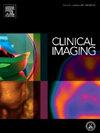优化髌骨成像:每个放射科医生都应该知道的
IF 1.8
4区 医学
Q3 RADIOLOGY, NUCLEAR MEDICINE & MEDICAL IMAGING
引用次数: 0
摘要
髌骨是最大的籽骨,是膝关节生物力学功能的组成部分。它是股四头肌的支点,使它们在运动时稳定和收缩。由于其形状复杂,包括许多稳定结构和重要的关节部分,其评估和分析成为世界范围内放射科的一个具有挑战性的问题。在本文中,它的评价与常规x线摄影和多探测器计算机断层扫描,以及它在髌骨病理的作用,已经讨论。在进一步的讨论中,详细讨论了诊断滑车发育不良、外侧髌骨脱位和髌股不稳定的关键测量,如滑车沟角、Merchant's同余角和TT-TG距离。本文讨论了某些增强放射报告的技术和标准化,为最大限度地提高此类病理的诊断和管理提供了实用的观点。本文的目的不是规定明确的方法,而是以可靠的方式介绍正确的髌骨病理及其含义的工具。本文章由计算机程序翻译,如有差异,请以英文原文为准。
Optimizing patellar imaging: What every radiologist should know
The patella, biggest of all sesamoid bones, is an integral part of knee biomechanical function. It is a pivot for the quadriceps, enabling them to stabilize and contract during motion. With its complex shape, comprising many stabilizing structures and significant parts of articulation, its evaluation and analysis become a challenging issue in radiology departments worldwide.
In this article, its evaluation with conventional radiography and Multidetector Computed Tomography, and its role in patellar pathology, have been discussed. In an extended discussion, key measurements, such as the trochlear groove angle, Merchant's congruence angle, and TT-TG distance, in diagnosing trochlear dysplasia, lateral patellar dislocation, and patellofemoral instability, have been discussed in detail.
Certain radiological report-enhancing techniques and standardization have been discussed, providing a pragmatic view for maximizing such a pathology's diagnosis and management. The intention of this article is not to prescribe definite methodologies but to introduce tools for a correct patellar pathology and its implications in a reliable manner.
求助全文
通过发布文献求助,成功后即可免费获取论文全文。
去求助
来源期刊

Clinical Imaging
医学-核医学
CiteScore
4.60
自引率
0.00%
发文量
265
审稿时长
35 days
期刊介绍:
The mission of Clinical Imaging is to publish, in a timely manner, the very best radiology research from the United States and around the world with special attention to the impact of medical imaging on patient care. The journal''s publications cover all imaging modalities, radiology issues related to patients, policy and practice improvements, and clinically-oriented imaging physics and informatics. The journal is a valuable resource for practicing radiologists, radiologists-in-training and other clinicians with an interest in imaging. Papers are carefully peer-reviewed and selected by our experienced subject editors who are leading experts spanning the range of imaging sub-specialties, which include:
-Body Imaging-
Breast Imaging-
Cardiothoracic Imaging-
Imaging Physics and Informatics-
Molecular Imaging and Nuclear Medicine-
Musculoskeletal and Emergency Imaging-
Neuroradiology-
Practice, Policy & Education-
Pediatric Imaging-
Vascular and Interventional Radiology
 求助内容:
求助内容: 应助结果提醒方式:
应助结果提醒方式:


